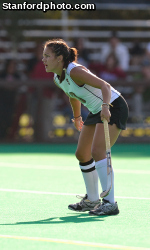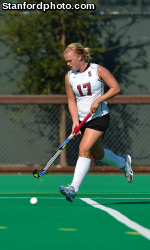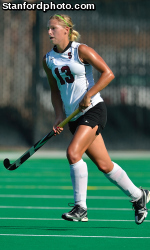Sept. 29, 2011
No. 6 Stanford Hosts Robert Morris Friday at 7 p.m.
STANFORD, Calif.- Long regarded as an afterthought, field hockey on the West Coast is suddenly garnering unprecedented national attention and Stanford is leading the charge.
Stanford (8-1, 3-0 NorPac) entered this week ranked No. 6 in the latest Kookaburra/NFHCA National Coaches poll. The No. 6 national ranking matches the highest in program history, first achieved back on Sept. 22, 1987, when the Cardinal also checked in at No. 6 following a 4-1 start. However, the No. 6 ranking from 1987 was determined by the NCAA's weekly top-20 poll, during a decade when field hockey was an emerging a sport played almost exclusively by East Coast schools.
Fast forward more than 20 years later and not much has changed. Of the 79 Division I schools sponsoring the sport, only four (Stanford, California, Pacific, UC Davis) represent the West, with those programs competing in the West Division of the NorPac Conference, whose East Division is comprised of Appalachian State, Davidson, Longwood and Radford. The next-closest schools in proximity to the West are those of the Big Ten Conference.
Stanford has already beaten three top-20 programs from the East (Albany, Northeastern, Indiana), with its only loss coming in the form of a hard-fought 4-2 setback at No. 4 Connecticut in which the Cardinal statistically won the second half.
That's not to say all of this has transpired overnight. Stanford has been a top-20 mainstay over the last four seasons, first cracking the national rankings in September of 2007 following a six-year absence. Ever since then, the Cardinal has played the role of an upstart team on the rise, bouncing around in the lower half of the poll. However, nine games into this year, Stanford has jumped 14 spots in one month since debuting at No. 20 in the preseason poll.
Also off to a fast start is rival California (8-2, 2-1 NorPac), which has defeated five ranked teams from the East. In fact, if not for a loss at Northwestern one week earlier, the Golden Bears might have even joined Stanford in the top-10. In perhaps an ultimate sign of West Coast respect, California actually moved up one spot in the rankings to No. 11 despite suffering a 3-2 loss to Stanford last week in a battle of the NorPac's elite teams.
Head coach Tara Danielson acknowledged there is still considerable room to grow, but a West Coast field hockey program does offer some advantages.
"We have a year-round curriculum that never has to be modified because the weather conditions are always ideal," said Danielson, in her second season at the helm. "So we really are able to progress our players along throughout the year. Also, Stanford is at the forefront of innovation, employing a collaborative approach with different departments such as Sports Performance, Human Performance, Sports Medicine and Biomechanics. We are tapping into all these resources so that our student-athletes can benefit in competition."
As one would expect, Stanford's roster has traditionally included several players from the state of California (this year's count is seven). Meanwhile, the Cardinal continues to maintain a strong national recruiting presence as well, while recent additions from Canada and England have also paid immediate dividends.
That being said, field hockey on the West Coast can no longer be ignored. Consider the viewpoints of three Cardinal players, who hail from different regions within California.
- - - - - - - - - - - - - - - - - - - - - - - - -
 Co-captain Stephanie Byrne leads Stanford with seven assists through nine games. |
Senior Stephanie Byrne had never heard of field hockey before her freshman year at Saint Francis High School.
"I was at an open house and they were like: `Oh, you play soccer? This will be fun, come to a camp.' So I checked it out and that was my first exposure to the sport."
A native of San Jose, Byrne had initially thought about attending college on the East Coast. After taking multiple visits and narrowing her choices to Boston College, Indiana, Northeastern and Providence, Byrne decided she could not turn down the world-class combination of academics and athletics Stanford had to offer.
"I remember hearing about all the recruits Stanford was getting," said Byrne, a co-captain this year and 2010 All-NorPac selection. Camille (Gandhi) and Xanthe (Travlos) had just started here and I can recall going to the games, thinking how much I wanted to play with those guys. The year before (2007) was sort of a rebuilding year. They had just won the NorPac Tournament and finally ended the long losing streak against Cal. The program was coming up."
Talk about recruiting promises delivered. Since Byrne's arrival on The Farm, Stanford has compiled a 49-23 record, claimed three straight NorPac Tournament titles and won seven of the last 10 meetings against California after the Golden Bears had won 18 in a row from 2001-2007.
Byrne is the latest in a long line of talented local products to make an impact on the program, joining current teammates Katie Mitchell (Saint Francis HS) and Elise Ogle (Gilroy HS), along with recent standouts Nora Soza (Archbishop Mitty), Jaimee Erickson (Los Gatos HS) and Bailey Richardson (Los Gatos HS).
"I feel like West Coast field hockey is really growing," explained Byrne. "All of a sudden, you have little sisters who want to play. My cousin started playing because I was playing. There are more programs available now for younger players. Seeing so many high school teams out at our games is really cool."
Byrne also cited the influence of Danielson, a native of Greenfield, Mass., and four-year letterwinner at the University of Massachusetts who has since established a reputation as a pioneer for field hockey on the West Coast.
"Tara understands the different dynamic of the West Coast. The girls out here haven't been playing the sport for that long, but she is able to bring us to that level through her experiences in the game on a national scale."
The Bay Area native is hoping for continued success in her final season.
"We are finally getting the respect we deserve and I don't feel like we are overlooked anymore," added Byrne. "This can only help us in the future with recruiting because we are now a top-10 team. It's an exciting time for our program and the conference."
- - - - - - - - - - - - - - - - - - - - - - - - -
 Emily Henriksson is one of 11 players to score at least one goal for Stanford this year. |
Much like her NorCal counterpart Byrne, SoCal native Emily Henriksson didn't realize what she was getting into when first approached about field hockey.
Growing up in a family that was heavily involved in sports, Henriksson was active in soccer, swimming, basketball, softball and tennis. However, Henriksson's introduction to field hockey came in the seventh grade when a friend decided to try out for the team one afternoon. Henriksson was told it was like playing "ice hockey on grass".
"My mom was a teacher there at the school, so I went over to her classroom and asked if she could wait another hour for me," said Henriksson, competing in her second full season with the Cardinal after sitting out the 2009 campaign as a redshirt. "I told her I was going to try out for this thing called field hockey."
Everyone who participated in those tryouts ended up making the team. Henriksson stuck with it for the entire season, improved her game and was referred to a Harvard-Westlake camp. From there, one of the parents recommended Henriksson try out for the Futures program, considered a pipeline for selection to the National Team and Olympic Development Program.
Henriksson continued her progression, qualifying for Junior National Camp and competing as a member of the Hollywood club squad. In addition to gaining experience while playing some matches on the East Coast, Henriksson was becoming more informed about opportunities within the field hockey community.
"Through my experience with Hollywood, I was introduced to Moorpark, which at the time served as the headquarters for the men's national team," said Henriksson. "As a result, I was able to meet those players, and train with them sometimes on weekends."
Even though Henriksson seriously considered attending Harvard, her top choice from the outset was Stanford.
"Stanford was very interested in me early on, and I was very interested in Stanford. That relationship was built. I felt comfortable and pretty set on Stanford. When I came here on my visit, I already knew half the team through competition and that was one of the deciding factors. We had already shared experiences."
Henriksson has embraced Stanford's emergence as a national power.
"There was definitely a sense of pride, staying on the West Coast," said Henriksson, who is joined by SoCal counterpart Colleen Ryan (Huntington Beach HS) on the Cardinal roster. "I came to this program anticipating field hockey would be a growing sport out here. I think UC Davis was just starting up its program at the time. The fact that Cal is doing so well right now also is great. It just gives West Coast field hockey a better rep and brings our league more respect. This is really an exciting time for us and the fact that we're beating quality teams feels so good."
- - - - - - - - - - - - - - - - - - - - - - - - -
 Freshman Kelsey Harbin made an impact in her debut, scoring the overtime game-winner in a 4-3 victory at Hofstra. |
Much of Stanford's early-season success can be attributed to contributions from an impressive freshman class, led by Escondido native Kelsey Harbin.
Harbin started out playing basketball, but followed her older sister, Kristen, into the sport of field hockey while in middle school. At the time, Danielson was entrenched in her role of Chief Executive Officer of RUSH Field Hockey, Inc., a non-profit public benefit corporation committed to the development of field hockey in Southern California.
"Tara and Steve (assistant coach Steve Danielson) were the reason I continued to play," said Harbin, a 2011 graduate of San Pasqual High School. "They were really the only coaches in the San Diego area at the time, so I started participating in their clinics and just fell in love with the sport. They were all about California pride in field hockey. Even though Tara grew up and spent time on the East Coast, she is all about establishing field hockey in California and making it a bigger sport. Those two played a tremendous role with me getting into the sport."
A three-sport standout in high school (field hockey, basketball, track), Harbin finally decided during her sophomore year to pursue a field hockey scholarship. She expressed interested in several schools outside of California, taking visits to Boston College, Northwestern, Princeton and Richmond.
Harbin's experience in the sport up to this point has allowed her to notice the difference. Consider this: a member of the U.S. U-19 National Team, Harbin is the only West Coast participant on an 18-player roster.
"California girls just aren't surrounded by field hockey all the time," explained Harbin, who along with Devon Holman (Fallbrook HS) are tied to the San Diego area. "You're lucky to find a pick-up game out here. The style is different. Although we don't have as much skill training as East Coast girls, it seems like players from the West Coast make up for it by being extremely athletic and just excited to be involved in a new sport. A lot of times players from the East Coast are shocked when we play in tournaments and start winning, because it's girls who are athletic and just have that passion to play. That's how California is making more of a name. Then hopefully as the skill develops, we'll be able to close the gap."
Harbin cited multiple reasons Stanford can emerge as a big-time player in a landscape traditionally dominated by East Coast schools.
"Not only does Stanford have the great academic reputation, but now the field hockey team has been building a reputation for being a better team," said Harbin. "Just the fact that it's in California, why wouldn't you want to come here? Excellent academics, a highly-ranked team and beautiful weather. We're only going to get better and better, because we have all year to train outside on that turf. East Coast schools are stuck inside during the offseason and can only do so much during the winter. We're able to train outside on our turf all year around."
Of course, the recent winning trend helps too.
"We've always known that we could compete at this level. We are just as good, but no one has seen it until every week we just keep climbing in the rankings."
by Brian Risso, Stanford Athletics Communications/Media Relations